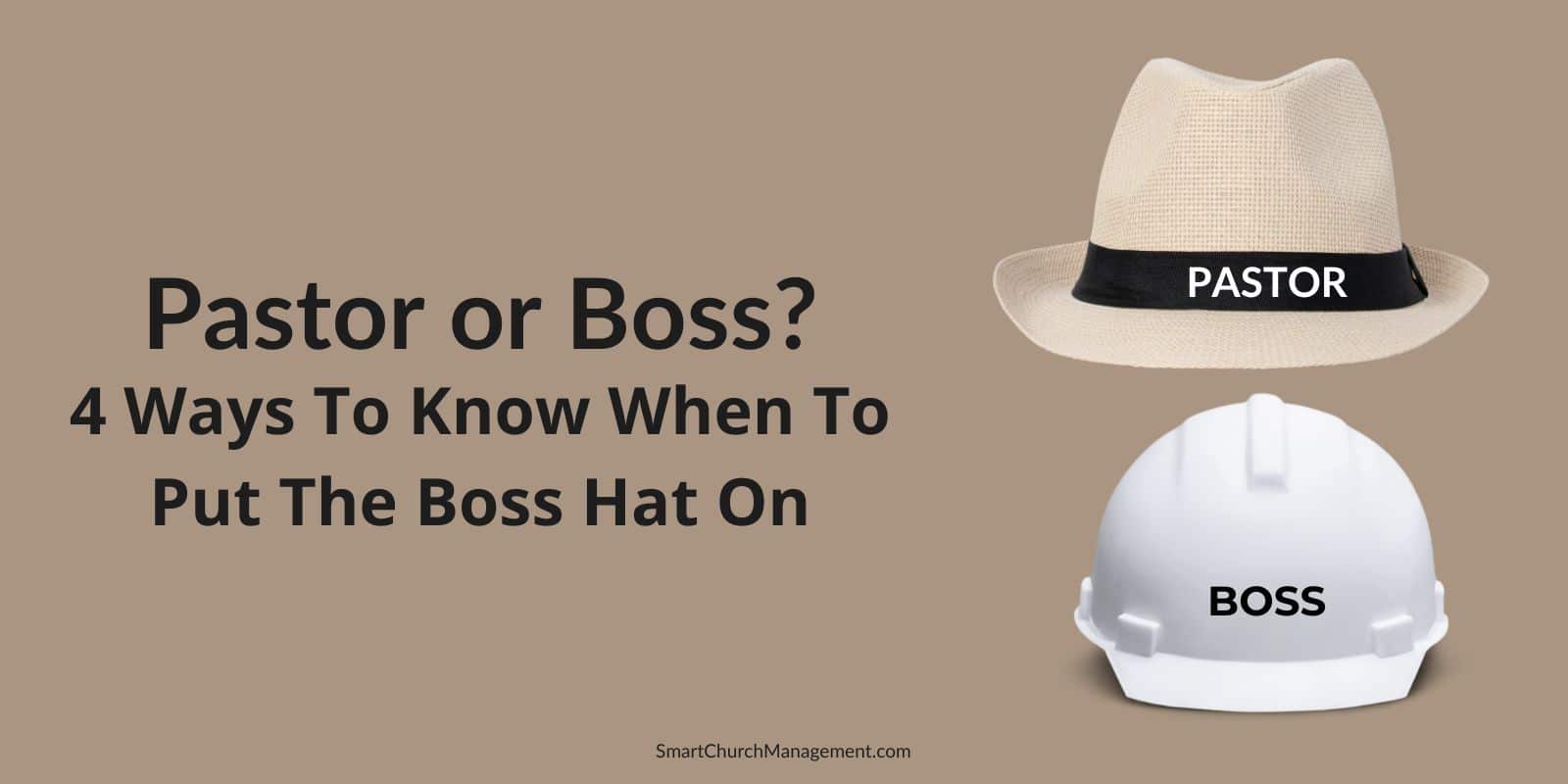Estimated reading time: 5 minutes
Being responsible for overseeing a church congregation can be very challenging because of the tender balance between pastoring and pursuing a shared vision.
Church leaders are sometimes challenged with knowing when to operate in one of two roles – pastor or boss. We need to recognize pastors for this difficult balance.
Pastor or Boss?
When asked how to respond to different management issues, I ask leaders: Is this a boss or pastor issue?
In other words, which hat needs to be worn to deal with this issue – the pastor hat or the boss hat?
This is because of the different approaches used in each of these roles.
A pastor is defined as
“a person who has the spiritual care of a number of persons.”
Whereas a boss is
“a person who makes decisions and exercises authority.”
These two very different responsibilities can conflict with each other.
Knowing which hat to put on for the issue at hand helps to ensure an appropriate response.
It Is Important To Know Which Hat To Put On
Responding to a pastoral issue with a boss hat on can create relational problems that may be difficult to mend.
For example, if an employee is dealing with some health issues that affect their ability to get their job done, a pastoral approach would be to give the employee grace and flexibility through the situation.
However, responding to a boss issue through the lenses of a pastor can result in avoiding the needed direct response and ultimately lead to a poor outcome.

For example, an employee who has been made aware of an ongoing issue with the quality of their work needs to be addressed directly and formally.
This is not the time to pastor them. It is the time to encourage improved performance.
In the first example, employees should be given grace temporarily when they are dealing with personal issues.
However, an employee who is not confronted about not getting the job done is harmed.
For the simple reason that when issues are not addressed, the person is given a false belief that their performance is acceptable.
This is not fair to the organization or the employee.
4 Ways to Know When to Put the Boss Hat On
1. Expectations Are Not Being Met
Managing the performance of employees and volunteers is critical to achieving the mission of the organization.
We’ve all been there.
We expect an employee to complete a task only to learn it wasn’t done. We discover that it wasn’t done and are unsure how to respond.
Times like this can be very frustrating, especially when we think the expectations were made clear and everyone was on the same page.
For example, an action item on the facility review committee was to plan a volunteer campus cleanup day.
The item was due to be completed by the end of June, and here it is, the beginning of August, and it has not been done yet.
In these types of situations, we may have the tendency to give a little grace because the delay may have been justified.
However, it is vital to put the boss hat on and confront the person responsible for completing the task.
2. Numbers are Going in the Wrong Direction
Every organization should identify those things that determine its success. In other words, asking the question – how do we measure our success?
This is done by identifying and tracking critical success factors (CSF) so you know whether you are hitting the mark.
For example, a CSF may be the number of people volunteering, the number of members connected in small groups, or the average weekly attendance.
If one of these factors is declining, it may be time to put on the boss hat and ask the hard questions.
This means confronting the issue and determining the real (not perceived) reason for the decline.
For example, the Five Whys Quality Tool is a great way to determine why members are not connecting in small groups.
It may also require asking for feedback from members, volunteers, or employees.
Asking the question can begin the process of understanding the issues and working toward turning those numbers around.
3. When Conflict Arises
Let’s face it, no one likes conflict. When conflict arises in the church, leadership needs to take quick action to resolve it.
There is a theory in conflict management that suggests that the longer a conflict goes unresolved, the more difficult it becomes to manage and turn around.
Unresolved conflict in church results in misunderstandings, hurt feelings, and, unfortunately, people leaving.
So whether the conflict is between two employees, a church member challenging church policy, or a volunteer acting inappropriately, these issues must be addressed directly and quickly.
Church leaders often have the distorted notion that addressing conflict is un-Christlike. The fact is, the opposite is true.
4. When Someone Needs to Make the Tough Call
Anyone in a leadership role has experienced a time when a tough call had to be made. In those times, we need to put on the boss hat.
It may be a decision to change the leadership in a certain role or perhaps to let a church employee go, or it could be a decision to cut spending so funds can be diverted to something that better supports the mission.
Each of these examples impacts people, which is why making the tough call can be very difficult.
Most Decisions Impact Other People
Putting on the boss hat and making the tough call, with the love and care of a pastor’s heart, is the best way to reach a positive outcome.
Resolving conflict and managing people can be difficult, but if done effectively can be very rewarding.
Knowing when to be the pastor and when to be the boss can be the perfect balance in moving employees, volunteers, and members into their perfect place and ultimately help fulfill the church’s mission.
Learn more tips for managing your church by enrolling in our Church Administration course.



